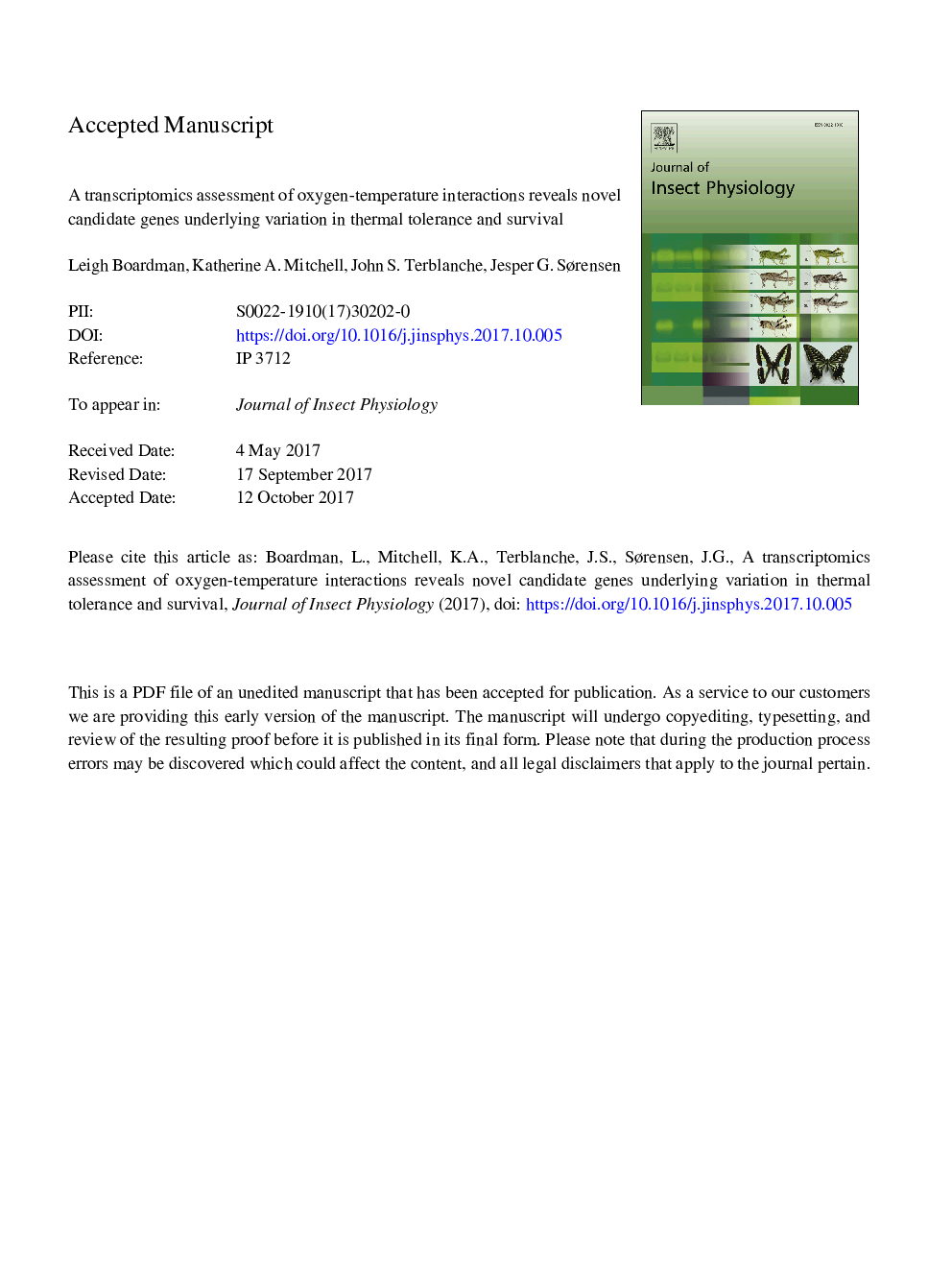| کد مقاله | کد نشریه | سال انتشار | مقاله انگلیسی | نسخه تمام متن |
|---|---|---|---|---|
| 8649794 | 1570964 | 2018 | 29 صفحه PDF | دانلود رایگان |
عنوان انگلیسی مقاله ISI
A transcriptomics assessment of oxygen-temperature interactions reveals novel candidate genes underlying variation in thermal tolerance and survival
ترجمه فارسی عنوان
ارزیابی ترانسکتنمیکا از تعاملات دمای اکسیژن نشان می دهد که ژن های نامزدی جدید دارای تغییرات اساسی در تحمل گرما و بقا هستند
دانلود مقاله + سفارش ترجمه
دانلود مقاله ISI انگلیسی
رایگان برای ایرانیان
کلمات کلیدی
موضوعات مرتبط
علوم زیستی و بیوفناوری
علوم کشاورزی و بیولوژیک
دانش حشره شناسی
چکیده انگلیسی
While single stress responses are fairly well researched, multiple, interactive stress responses are not-despite the obvious importance thereof. Here, using D. melanogaster, we investigated the effects of simultaneous exposures to low O2 (hypoxia) and varying thermal conditions on mortality rates, estimates of thermal tolerance and the transcriptome. We used combinations of 21 (normoxia), 10 or 5 kPa O2 with control (23 °C), cold (4 °C) or hot (31 °C) temperature exposures before assaying chill coma recovery time (CCRT) and heat knock down time (HKDT) as measures of cold and heat tolerance respectively. We found that mortality was significantly affected by temperature, oxygen partial pressure (PO2) and the interaction between the two. Cold treatments resulted in low mortality (<5%), regardless of PO2 treatment; while hot treatments resulted in higher mortality (â¼20%), especially at 5 kPa O2 which was lethal for most flies (â¼80%). Both CCRT and HKDT were significantly affected by temperature, but not PO2, of the treatments, and the interaction of temperature and PO2 was non-significant. Hot treatments led to significantly longer CCRT, and shorter HKDT in comparison to cold treatments. Global gene expression profiling provided the first transcriptome level response to the combined stress of PO2 and temperature, showing that stressful treatments resulted in higher mortality and induced transcripts that were associated with protein kinases, catabolic processes (proteases, hydrolases, peptidases) and membrane function. Several genes and pathways that may be responsible for the protective effects of combined PO2 and cold treatments were identified. We found that urate oxidase was upregulated in all three cold treatments, regardless of the PO2. Small heat shock proteins Hsp22 and Hsp23 were upregulated after both 10 and 21 kPa O2-hot treatments. Collectively, the data from PO2-hot treatments suggests that hypoxia does exacerbate heat stress, through an as yet unidentified mechanism. Hsp70B and an unannotated transcript (CG6733) were significantly differentially expressed after 5 kPa O2-cold and 10 kPa O2-hot treatments relative to their controls. Downregulation of these transcripts was correlated with reduced thermal tolerance (longer CCRT and shorter HKDT), suggesting that these genes may be important candidates for future research.
ناشر
Database: Elsevier - ScienceDirect (ساینس دایرکت)
Journal: Journal of Insect Physiology - Volume 106, Part 3, April 2018, Pages 179-188
Journal: Journal of Insect Physiology - Volume 106, Part 3, April 2018, Pages 179-188
نویسندگان
Leigh Boardman, Katherine A. Mitchell, John S. Terblanche, Jesper G. Sørensen,
